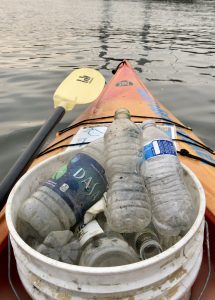Our Work Healthy Waters Programs & Initiatives Microplastics & Marine Debris
Microplastics & Marine Debris
 Plastic is the most prevalent marine debris in our oceans and Great Lakes. Plastic debris can come in all shapes and sizes, and those that are less than five millimeters in length are called microplastics. There are a variety of types of microplastics—primary microplastics that are manufactured as microbeads or production pellets, and secondary microplastics (e.g., film, fragments, fibers, and foam) that are formed by the breakdown of things like water and pop bottles and other single-use plastics into smaller and smaller pieces. These tiny particles easily pass through water filtration systems and end up in our waterways, potentially threatening aquatic life.
Plastic is the most prevalent marine debris in our oceans and Great Lakes. Plastic debris can come in all shapes and sizes, and those that are less than five millimeters in length are called microplastics. There are a variety of types of microplastics—primary microplastics that are manufactured as microbeads or production pellets, and secondary microplastics (e.g., film, fragments, fibers, and foam) that are formed by the breakdown of things like water and pop bottles and other single-use plastics into smaller and smaller pieces. These tiny particles easily pass through water filtration systems and end up in our waterways, potentially threatening aquatic life.
Working collaboratively with regional partners, the National Oceanic and Atmospheric Administration Marine Debris Program and IISG developed a campaign to educate the public about the hazards of plastic pollution and encourage the best way to reduce plastic in the environment—by cutting down on its use in the first place. The Bring It From HOMES campaign encourages REUSE by REFILLing your water bottles at home in order to REDUCE plastic pollution in Lakes Huron, Ontario, Michigan, Erie, and Superior—keeping our Great Lakes great.
 Bring It From HOMES graphics are free to use by any organization that wants to prevent plastic pollution in the Great Lakes. Visit go.illinois.edu/HOMES to download them and look for Bring It from HOMES on a water bottle or beach sign near you!
Bring It From HOMES graphics are free to use by any organization that wants to prevent plastic pollution in the Great Lakes. Visit go.illinois.edu/HOMES to download them and look for Bring It from HOMES on a water bottle or beach sign near you!
Marine debris and microplastics are an emerging field of study, and much is unknown about their impacts on aquatic ecosystems, particularly the long-term effects. While study of the fate, transport, and effects of plastic contamination in the oceans have been building for some time, similar knowledge in freshwater systems is greatly lacking. The ecosystem impact of plastic litter (from nano- to micro- to macro-sized) in the Great Lakes is a growing area of research. The impacts of this emerging contaminant will be difficult to manage in the future without a robust, well-coordinated, evidence-driven knowledge base.
Contact Info
Topic Specialist
Research Projects
Publications
Education & Training
Related News
- In 2026, IISG intends to fund 10 research projects focused on coastal concerns
- New step-by-step guide and veterinary brochures expand UnwantedMeds.org resources
- Join IISG as a new pollution prevention outreach assistant
- Relaunched website provides resources for proper medicine disposal
- Meet our Grad Student Scholars: Haribansha Timalsina
